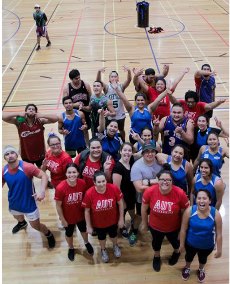Ki-o-rahi tournament celebrates Matariki

To celebrate the start of Matariki, AUT’s Maori Students Association (Titahi Ki Tua) held a Ki-O-Rahi tournament at its North Shore Campus recently.
The event was a huge success with four tertiary institutions pitted against each other, including AUT University, University of Auckland, Unitec, Te Wananga Aotearoa, and Titahi Ki Tua.
Titahi Ki Tua were the proud winners of the tournament.
The tournament is a student-led movement to revive this historic game and celebrate the importance of cultural connectivity while studying at university, says AUT sport and recreation student and Titahi Ki Tua member, Takoha Ropati.
“It’s a great way for us to come together and celebrate our culture in an open environment that connects sport, culture and education,” says Ropati, who is also Kaiwhakahaere/co-ordinator for the revival of Maori Games at Harbour Sports.
AUT sport and exercise science senior lecturer Robert Hogg, says a sport like Ki-O-Rahi has its own whakapapa - its own genealogy, its own rich history - which brings with it a different way of conceptualising, and therefore understanding, the deeper layers of the sport.
“At its centre, Ki-O-Rahi like all sports is physical activity. What differentiates Ki-O-Rahi from other mainstream sports is the use of cultural constructs that represent a Maori way of knowing and being, for example the scoring posts or pou that represent Matariki,” explains Hogg.
“Ki-o-rahi is a vehicle that can be used to engender community spirit by bringing people, and students, together from all walks of life. Although these students represent different tertiary institutions, today is an example where Maori have come together to participate in a cultural activity that reaffirms our identity as Maori.
“It is the whakawhanaungatanga - relationship building between these students in a cultural way within an educational environment - that makes today so special,” says Hogg.
About Ki-O-Rahi
The pre-European Maori ball game Ki-O-Rahi is a fast-paced contact sport – some say a forerunner to rugby – which is played on a circular field, involving imaginative handling and swift interpassing of a ‘ki’ (ball).
Ki-O-Rahi is best remembered from WW2 when Maori soldiers, including those of the 28th Maori Battalion, demonstrated the game and passed on the game traditions to French and Italian soldiers and civilians who then took it back to their regions.
The game was also used as training for young Maori warriors. Ground rules varied between tribes. A tribe that had strong ball players could be asked by another tribe to join them in battle through the presentation of a ki or poi - a flax ball attached to a short string.